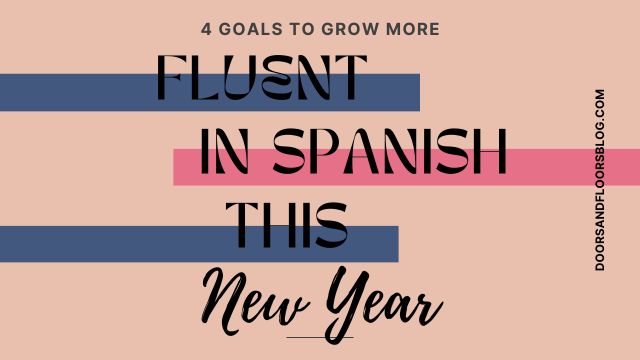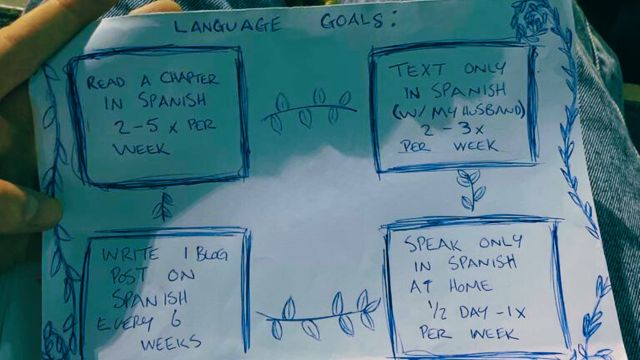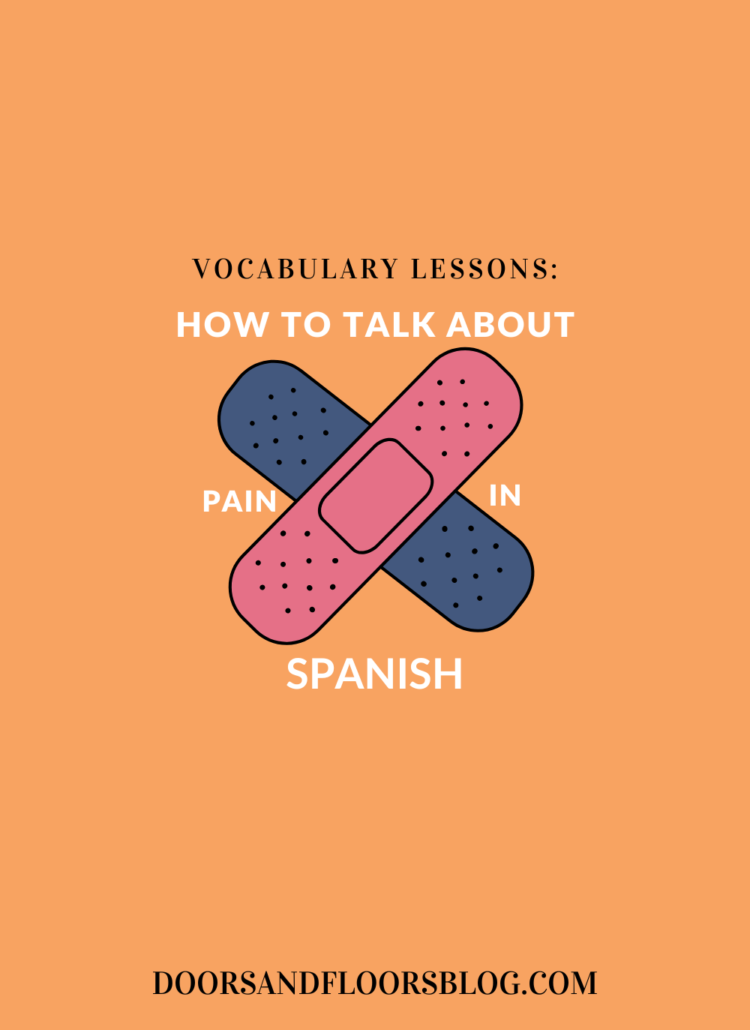
Hiiii!!
It’s the start of a New Year, so it’s time to talk about goals we can make to grow more fluent in Spanish. A New Year can be great for beginning again and starting fresh on your goals. Not that you can’t start new goals in the middle of the year, but there’s something special about starting at the beginning of the year.
If you’re trying to grow more fluent in Spanish this New Year, then I’ve got four goals for you. I’ll also give you some tips on how I plan to stick to my goals to make sure I achieve my ultimate end goal in learning Spanish.
Let’s get into it!
This post may include affiliate links.
Please read my disclaimer page for more info.
*As an Amazon Associate, I earn from qualifying purchases.*
Keeping Your Goals
Setting goals for the New Year can be intimidating. The “what ifs” creep in and we ask ourselves how to stick to and achieve them after -or if – we miss a day. Well, I’m here to tell you…realistically…you’ll probably miss a day here or there. And that’s okay!
We ask ourselves these questions because we recognize that we’re human and life happens. We might get sick or spontaneously go to activities that keep us from being able to achieve today’s goal. In times like this, it’s important to remind ourselves that the goal is the end result, not a perfect daily completion of a task. Because perfection is overrated and asking that of ourselves is too much. Give yourself some grace and set realistic and achievable boundaries and goals.
To help us grow more fluent in Spanish we’re going to set progressive goals that can be implemented into our daily routines. By implemented, I don’t mean we’re going to add an additional task on top of your already long list of tasks. I mean we’ll make some reasonable swaps. We need these goals to work for us, not against us.
When we set progressive goals, one step at a time we get closer and closer to attaining our end goal. Eventually, over time as we keep taking these steps, new things should become easier and faster to learn and they should start to snowball into the others.
These goals are also to be worked on throughout the whole year. Not for a month or a week and then we wonder why we don’t see any progress or why we get burnt out. By making goals with a one-year timeline we don’t have to get stressed out and “make up for lost time” if we unexpectedly get sick or want to take a vacation. We’ve got a year. We’ve got time. Any growth is progress. The end goal is to become “More fluent” not “Perfect in Spanish.” So please remember to remove that pressure from your shoulders. Again, perfection is overrated and not something we’re shooting for here.
Goal One: Reading Spanish

I know, adding an extra 15-20 minutes into your day to read Spanish is something you don’t have time for. If you add too many things to your plate, it will be easy to skip them on a busy day. To help us stick to this goal it needs to be implemented into our daily routine.
Do you do any reading throughout your day? Could you simply swap one chapter of your English book for your Spanish book? You don’t have to start with a lot. If you normally read three chapters of a book twice a week, try reading one less chapter in English and reading a chapter of something in Spanish once or twice a week instead.
Even if you don’t fully understand what you’re reading in Spanish, simply taking the time to read one chapter one to three times a week will really help you to grow more fluent in Spanish. If you keep this up, you’ll definitely see a difference in your fluency by the end of the year.
I recommend you get a book you’ve read already in English so the story is at least familiar. For me, I’ll be reading my Bible. I already have an English and Spanish version and I read a few chapters of my English Bible about five times per week. I plan to swap out one of my English chapters for a Spanish chapter and when possible, take notes and/or read aloud.
My Spanish Bible has a lot of extra writing and drawing space, so it makes it easier to take notes and stay focused.
Goal Two: Growing and Sharing Spanish Knowledge

I recommend you grow your knowledge through watching YouTube videos or reading books or blog posts. We have a couple of posts here to get you started in your learning.
- How To Improve Beginner Spanish With 10 Easy Categories
- How To Understand A Menu In Spanish When You Don’t Really Speak Spanish
- 12 Ways To Improve Your Language Learning – Without An App!
The important next step here is that you share what you’ve learned. If you don’t use what you learn, you won’t remember it. I cannot tell you the number of times my husband has told me what a word means and how it’s pronounced, only for me to immediately forget it because I never used the word again.
I’ve heard somewhere that the proof that you’ve learned something is when you can teach it.
So we’re going to make a goal to share what we’ve learned every few weeks. Consider telling your siblings, a friend, or your parents. You certainly do not need to go teach a class. You only need to get it out of your head and verbally use it again so that you can retain that knowledge.
My goal is to write one blog post on Spanish every six weeks. If I’m writing a post for my blog that often I should be learning and researching. Which I hope means I can grow fluent in Spanish.
Goal Three: Writing Spanish

Don’t be intimidated by this goal. When I say “write” I don’t mean a novel or anything large. I mean texting. Applicable steps, remember? I don’t have time to try to write a story or a letter in Spanish either, so don’t pressure yourself.
If you have a friend who is trying to learn Spanish or know someone fluent who you can text, I would recommend you text one of them. Make a goal to text only in Spanish with them once a week. Try to work your way up so that towards the end of the year you’re texting them more frequently only in Spanish.
When I say text in Spanish, I also don’t want to rule out using a translator app. Use it to your heart’s content! Simply taking the time to type in Spanish and have a written conversation, even if it forces you to research and use the translator, will be really good for you. Because without texting, you won’t even be put into positions where you need to use an app or converse.
Also, texting in Spanish is less intimidating than verbally conversing. You can take 20+ minutes to respond to questions, instead of trying to translate in your head and figure out what you need to respond immediately.
Actively writing in Spanish is so good for helping you learn and grow your Spanish. I highly recommend it if you can find someone to communicate with and have regular, everyday conversations with them. During these early stages of learning Spanish, it is key to practice conversing with others.
Personally, I have multiple people I could choose to text, from my brother who is also learning Spanish, to numerous in-laws. While I do text these people on occasion, I’ve chosen for this goal to text my husband only in Spanish 1-3x per week. He is someone I communicate with regularly over text, and most importantly, he is a safe space and won’t judge me if I say or type something wrong. He’ll provide gentle corrections, which will help me to really grow my Spanish.
Goal Four: Speaking Spanish

Lastly, we need to make sure we’re speaking Spanish at some point. Whether this is to yourself in the shower, to your spouse or a friend. You could even practice along with an app or a YouTube video. The who is less important so long as you’re actually doing it.
Consider making a goal to speak only in Spanish for a whole day once a week. If you work from home or live alone, you can talk to yourself as you go about your day, repeating out loud the things you’re doing as you go. If you can practice with a person though, this would of course be better.
I have an ultimate goal to regularly speak only in Spanish when at home. But we’ll work toward that in the future. For now, if I can start with just speaking for half a day in Spanish when I’m at home, I know I can then work toward doing a full day once a week. I hope by the end of the year I’ll be chatting regularly in Spanish when I’m at home with my husband.
These are goals I can do at home – but I also live in Perú. So I’m immersed in the culture and my in-laws come over often. That helps me with conversations as well. Of course, please make this applicable to you and your environment.
Though I’ve never spent a whole day only speaking Spanish (outside of work). I tend to mostly speak Spanish when my in-laws come over and I get lazy the rest of the time. This goal will help me think on my feet, allowing me to pull from my Spanish vocabulary and not rely solely on English.
Questions like, “Como se dice…” are of course encouraged on Spanish-only days.
Creating Your Language Goal Board

Here are the four goals I’m putting on my list to help me grow more fluent in Spanish this year. Please be realistic with yourself in each category and customize it to your own needs and goals. Write yours down and hang them somewhere so you can refer back to them throughout the year.
What goals do you have in your language learning journey? Let me know in the comments if you decide to add any of these to your list! And keep me posted on your progress!
Explore other recent posts:
- More Great Sewing Projects To Use Up Leftover Fabric
- How To Successfully Make $0.00 Online While Working A 9-5
- How To Make A Satin Lined Beanie From Fabric Scraps
- The Most Important Travel Items For Your Next Trip
- No More Beef With My Skin: How Tallow Transformed My Skincare Routine

Find us on social media!
P.S. Looking for a fun activity to play while traveling to your next adventure? We put together a great freebie that you can play with your seatmate on a plane, train, or long bus ride, download your free trivia here.
Playing trivia is a great way to participate in fun activities with your friends and family, even when you’re 4,591 miles apart or constantly on the go. It helps you keep your long-distance relationships growing and is sure to provide lots of fun!






